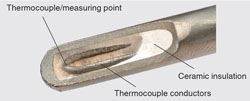Sheathed thermocouples differ from conventional thermocouples in their smaller construction and their ability to be bent. Due to these features, sheathed thermocouples can also be used in places that are difficult to access.

Assembly of sheathed thermocouples
Sheathed thermocouples consist of an outer metallic sheath, which contains the insulated internal leads, embedded within a high-density ceramic compound (mineral-insulated cable, also called MI cable). Sheathed thermocouples are bendable and may be bent to a minimum radius of five times the sheath diameter. The extreme vibration resistance also supports the use of sheathed thermocouples.
For sheath materials, Inconel 600 or stainless steel are used preferentially. Inconel 600 (2.4816 Ni alloy) is the standard material for applications which require specific corrosion-resistant properties under exposure to high temperatures, resistant to induced stress corrosion cracking and pitting in media containing chloride. Sheathed thermocouples from Inconel 600 are resistant against halogens, chlorine, hydrogen chloride and ammonia in aqueous solutions. Sheathed thermocouples from 316 stainless steel stand out due to their good resistance against aggressive media and also against vapour and combustion gases in chemical media.
In our extensive range of sheathed thermocouples, you can find a suitable version for every application.
Frequently used sheathed thermocouples:
Type K: NiCr-NiAl thermocouples are suitable for use in oxidising or inert gas atmospheres up to 1,200 °C (ASTM E230: 1260 °C) with the largest wire size.
Type J: Fe-CuNi thermocouples are suitable for use in vacuum, in oxidising and reducing atmospheres or inert gas atmospheres. They are used for temperature measurements up to 750 °C (ASTM E230: 760 °C) with the largest wire size.
Type N: NiCrSi-NiSi thermocouples are suitable for use in oxidising atmospheres, in inert gas atmospheres or dry reduction atmospheres up to 1,200 °C (ASTM E230: 1260 °C). They must be protected from sulphurous atmospheres. They are very accurate at high temperatures. The source voltage (EMF) and the temperature range are almost the same as with type K. They are used in applications where a longer service life and greater stability are required.
Type E: NiCr-CuNi thermocouples are suitable for use in oxidising or inert gas atmospheres up to 900 °C (ASTM E230: 870 °C) with the largest wire size.
Type T: Cu-CuNi thermocouples are suitable for temperatures below 0 °C with an upper temperature limit of 350 °C (ASTM E230: 370 °C) and can be used in oxidising, reducing or inert gas atmospheres. They do not corrode in moist atmospheres.
The specifications for the use of sheathed thermocouples refer to versions with direct contact with the medium.
Type R, S and B thermocouples are also available embedded in MI cable. Temperature range, accuracy class and dimensions of these “noble” sheathed thermocouples should be clarified with your contact person.
Sensor tip designs of sheathed thermocouples

Contact us
Would you like further information? Write to us: